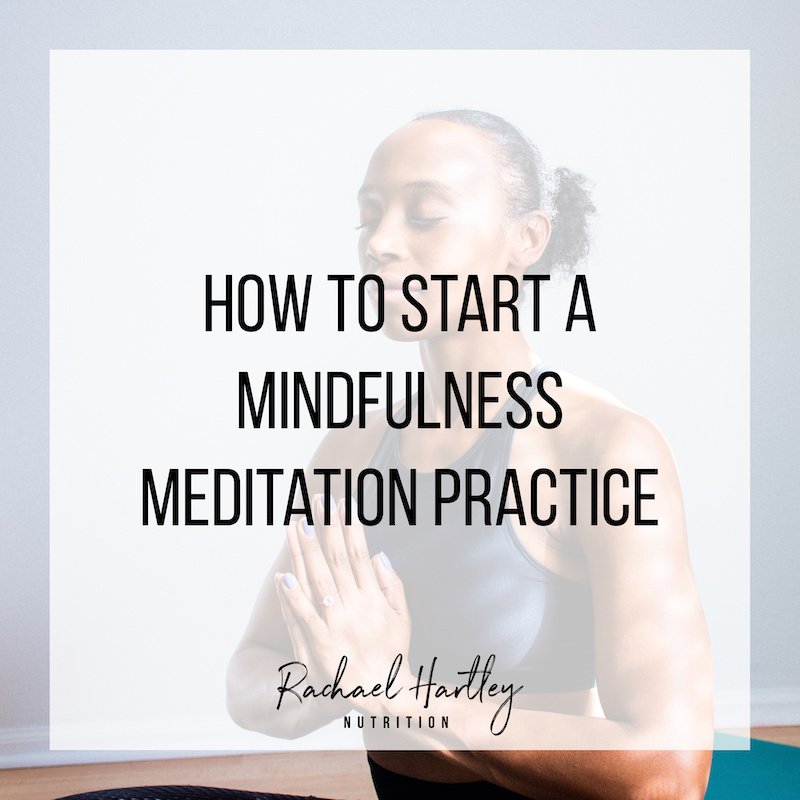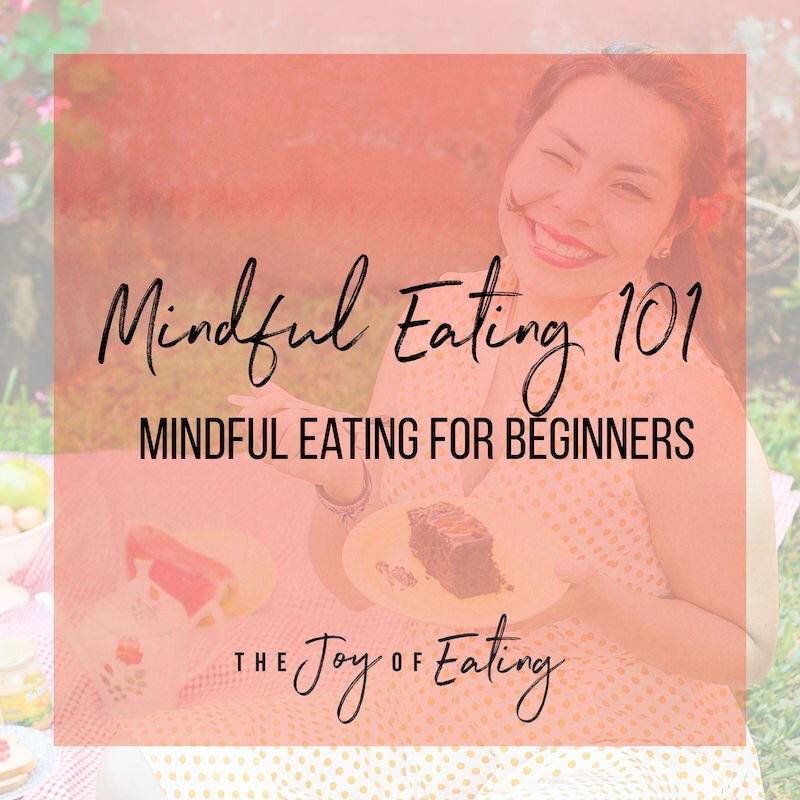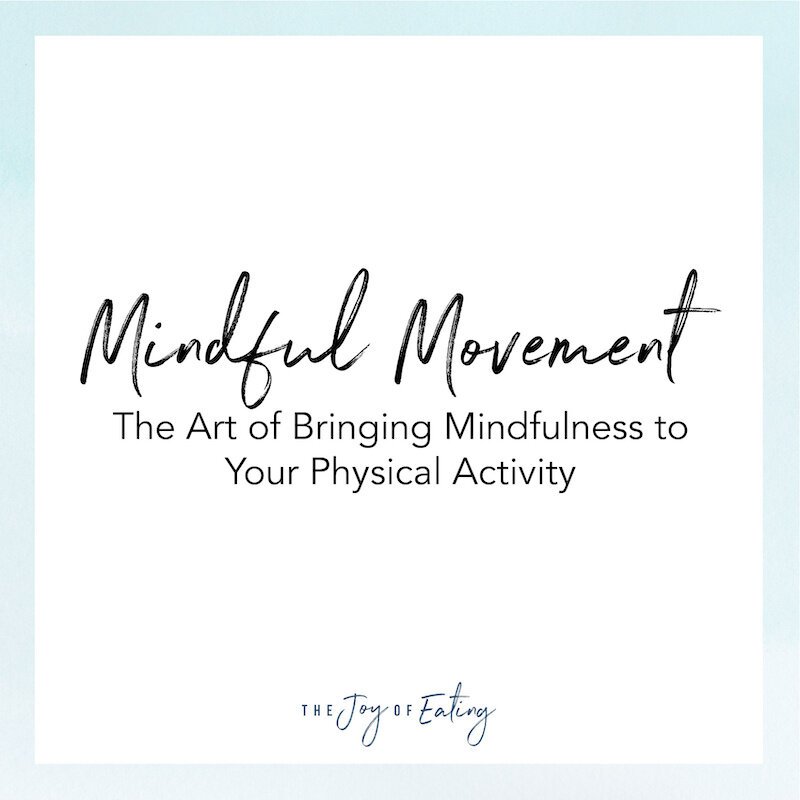How to Start a Mindfulness Meditation Practice
Building a mindfulness practice is incredibly helpful in healing your relationship with food, but mindfulness meditation can be intimidating, especially for beginners. Before jumping in, read this post to learn how to start a mindfulness meditation practice.
When I was first diagnosed with generalized anxiety disorder, one of the things my psychologist did was recommend I start a mindfulness meditation practice. I had been practicing yoga for about a year at that point, so meditation didn't seem like a huge leap. I mean, it was basically built into the end of each yoga practice with shavasana, right? And like, what’s so hard about being still and breathing?
The first time I tried to meditate, I found a nice, comfy pillow, sat down cross legged and closed my eyes. “Bring on the calm,” I thought! “I’m ready to be cured of my anxiety!”
Guys, apparently mindfulness meditation is one of those things that’s a lot harder than it looks.
Instantly, my mind jumped to my to-do list, running through all the things I could be accomplishing instead of meditating. “You’re not supposed to be thinking about your to-do list Rachael!” I yelled at myself internally. My heart rate began to rise. “Isn't meditation supposed to be calming?” I thought. Then I felt an itch on my back. It was an intense one - the kind you want to take care of, Baloo the Bear-style. Is scratching yourself while meditating allowed? Aren’t you supposed to sit perfectly still? I concentrated intensely on the itch, trying to will it to go away. As you can imagine, that didn’t work. And not only did it not work, but then my foot started to itch, followed by my legs, and pretty soon I felt like I had hives. Are hives a side effect of meditation? "Screw it," I said, scratching all over my body and relieving my itches, but intensifying a sense of failure.
After a minute or so of silently sulking over the fact that I couldn’t meditate, and therefore would be doomed to deal with anxiety for the rest of my life, I gave up. I grabbed my cell phone to turn off the alarm I had ambitiously set for 30 minutes, and immediately checked instagram.
The next week when I saw my therapist, I told him I was the worst meditator ever.
Thankfully, my therapist was wonderful and validating of my experience, and explained that this is something that happens to many, if not most people who are new to meditation. He also explained to me that when he said we’d be working on building a mindfulness meditation practice, he did not mean for me to go home and jump right into a 30 minute meditation. Whoops. I’d imagine that’s also the day that he added “work on being OK with C+ work” on our therapy to do list.
When I tried to start a mindfulness meditation practice again, I went in prepared, and had a much better experience (although how could it go worse?). I've had an on and off mindfulness meditation practice for almost 10 years now, and frequently use it as a tool with my private practice clients. I am by no means am I an expert, but there’s a lot that I’ve learned over the years since my first not so great experience with meditation, and in helping others start a mindfulness meditation practice.
Why You Should Start a Mindfulness Meditation Practice for Intuitive Eating
First off, let’s chat why I think starting a mindfulness meditation practice is so important for your intuitive eating journey.
Mindfulness helps you connect with your body, so you’re better able to feel hunger and fullness cues.
That body connection and awareness that’s built through mindfulness can also help you notice how food makes you feel.
Being able to notice your thoughts without immediately reacting to them (a skill that’s honed through mindfulness meditation) will help you notice when diet culture thoughts arise, and build a greater awareness of how your thoughts and feelings about foods affect eating behaviors.
Mindfulness can help you enjoy your food more, and connect with that satisfaction factor.
Mindfulness can also help you notice negative body image or food policing thoughts, so you have the opportunity to challenge or interrupt them.
It’s for these reasons and more that one of the first skills I work on with clients is often mindfulness!
How to Start a Mindfulness Meditation Practice
Here’s some tips that may be helpful for you in starting in a mindfulness meditation practice.
Have realistic expectations of your first time
The first time you meditate, do not expect to transcend into a blissed out level of zen. Very likely, your brain will be an anxious cloud of thoughts, and it will feel extremely difficult to focus on one thing. It’s OK. It’s normal. Think of it like the first time you got on a bike or played a sport. You probably felt pretty lost, but the more you practiced the more you built skills and confidence.
Start small
Bless my heart for thinking I could meditate for thirty minutes on my first try. Kind of like with food, people often want to make big, flashy changes and kick off with a bang. As we know, that rarely goes to plan. You'll be more successful at creating a mindfulness meditation practice, and get the most out of your practice, if you start out small and build from there. I recommend my clients start with a 2-3 minute mindfulness meditation, and no longer than 5. Even on days you have zero motivation, it's pretty hard to skip out on something that takes only a couple minutes. And even that little bit of time can be helpful in grounding and relaxing your brain.
If you can, pick a time and place
Meditation is said to be more effective if you practice at the same time of day and location. If you’re trying to build a regular meditation practice, keep in mind habits are best formed when you find a consistent spot for them in your schedule (finding a "spot" for health promoting habits is something I talk about in my book, Gentle Nutrition). Think about what works best for you, but it's helpful to pick a time slot that's after something you do regularly (i.e. after I brew coffee in the morning, after I check my emails, after I come home from work).
Next, choose a comfortable location. Meditating in the same spot will help condition your brain to settle into a meditative state when you're there. While sometimes I meditate in bed (our mattress is just so darn comfortable) I wouldn't recommend it because it's so easy to sleep instead of meditating. I recommend finding a corner in a quiet room where you can place a comfortable pillow or yoga mat. You can keep your meditation spot simple, or bling it out with a fancy meditation pillow and yummy candles.
That said, if you’re not able to, it’s totally OK to fit in meditation at random points in your day when you remember to do it, or feel like a meditation would be helpful. While it was helpful for me to have a routine at first, over time I moved away from that. Now I might pop in a 5 minute meditation between clients if my head is feeling a bit mushy, or take a longer chunk of time to meditate at night or on my admin days when I don’t have clients.
Foster a beginners mindset
There's a reason it's called a meditation practice. The first time you meditate, you won't have an aha moment or profound metaphysical experience. Stress won't disappear into thin air. You might even feel worse after meditating, especially if something negative pops up or if you went in with high expectations of the results. Let go of those expectations and focus on the experience.
How to Meditate
There’s a TON of different techniques for meditating, so feel free to explore what feels good for you. In this post, I’ll walk you through a really basic breath meditation.
First, before starting your mindfulness meditation, give your body a good stretch to help release tension, which can be distracting when you're laying down still for a period of time.
Next, set an alarm with a pleasant ring for 2-3 minutes, 5 minutes max. I use the Insight Timer app (free!) which allows you to set an alarm with fancy meditation chimes/gongs to start and stop your meditation, and has nice options for ambient noise .
Sit or lay down in a comfortable position in your designated meditation area. If it's cold, wrap yourself in a blanket and put on some socks.
Now you’re ready to get meditating. Close your eyes and breathe, concentrate on your breath. Don't try to change your breathing - just breathe naturally and observe what it feels like. What sensations do you experience as your lungs fill with air, and as that air comes back out through your nostrils. Notice the temperature difference of the cool air coming in, and warm air going back out. Notice where you feel the air coming in to your body. A mental image can be helpful, like visualizing waves rising and falling or flower petals opening and closing.
When you notice your brain wandering (it will), gently bring it back to your breath. Try not to judge your mind wandering. Treat thoughts that arise as clouds in the sky - let them pass by without latching on to them, and come back to your breath. The more you practice, the sooner you'll notice when your mind begins to wander, and the longer you’ll go without getting distracted.
It really is as “simple” as that! While mindfulness meditation may not involve complex instructions, remember that it is a challenge, so don’t feel bad if it feels much harder than expected.
I find guided meditations to be really helpful, especially for beginners. I really enjoy the aforementioned Insight Timer app (again, it’s free). I know a lot of people use Calm or Headspace, which are also great apps to use. Play around on YouTube, as there’s lots of free guided meditations on there!
Once you’ve gotten the hang of a basic meditation, feel free to experiment with different methods. You can do a body scan (a personal fave), progressive muscle relaxation (another fave), loving kindness meditation, or mantra meditation to name a few. The key is knowing there’s no right or wrong - just what feels good and is helpful for you!
We love to work with clients helping them integrate mindfulness into their eating! If you want to learn clear away the noise so you can feed yourself with confidence, we work with clients virtually and out of our Columbia, SC office. Learn more about our practice philosophy and nutrition services to see if we’re a good fit to work together.
This post on how to start a mindfulness meditation practice was originally published 3/15, and has been updated to give you the best possible content.
If this blog post on how to start a mindfulness meditation practice was helpful, follow my positivity Pinterest page for more inspiration.






